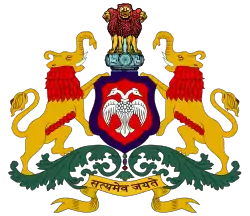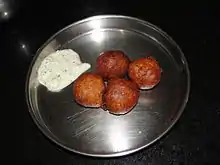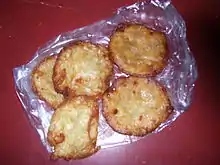Udupi cuisine
Udupi cuisine is a cuisine of South India.[1] It forms an important part of Tuluva-Mangalorean cuisine and takes its name from Udupi, a city on the southwest coast of India in the Tulunadu region. Udupi cuisine has its origin in the Tulu Ashta Mathas of Udupi founded by Madhvacharya.
 |
| This article is part of the series on |
| Indian cuisine |
|---|
|
| Part of a series on the |
| Culture of Karnataka |
|---|
 |
Udupi cuisine comprises dishes made primarily from grains, beans, vegetables, and fruits. The variety and range of dishes is wide, and a hallmark of the cuisine involves the use of locally available ingredients.
Following the tradition of chaaturmasa vrata, which is a restriction of certain food ingredients in a certain period or season, may have led to the innovation of a variety of dishes in Udupi cuisine. Pumpkins and gourds are the main ingredients in sambar, a stew prepared with ground coconut and coconut oil as its base.
The ubiquitous Indian dish dosa has its origins in Udupi, according to P. Thankappan Nair.[2] Saaru, a spicy pepper water, is another essential part of the menu, and so are jackfruit, colocasia leaves, raw green bananas, mango pickle, red chillies, and salt. Adyes (dumplings), ajadinas (dry curries or stir fry curries), and chutneys, including one made of the skin of the ridge gourd, are specialities.[3]
Typical dishes
- Ale Bajji
- Adde or Uh-day (a 'pancake' of various grams)
- Bajji
- Bakshya (sweet or dessert)
- Goli bajje (or Mangalore bonda)
- Huli (Similar to sambhar with ground coconut in the base)
- Kayathno or KaaYaadhina (fried items)
- Koddelu or sambar
- Kosambari (seasoned salad of lentils)
- Menaskai (variation of Sambhar)
- Paayasa (kheer)
- Paramanna (kheer)
- Rasayana (juice or squash or syrup)
- Saaru or rasam
- Spiced rice
- Tallu or Ajethna or ajadina (dry curry)
- Tambuli or watery vegetable paste (generally leafy vegetables) seasoned
Dishes served in a full course Udupi meal
The full course Udupi meal is served on a plantain leaf, which is traditionally kept on the ground. The dishes are served in a particular sequence, and each dish is placed on a particular spot of the plantain leaf. All the people eating this meal are expected to begin and end eating the meal together. A person cannot get up in middle of the meal, even though he has finished his meal. The start and end of meal is done by saying "Govinda," the name of Lord Vishnu. A typical meal is served with the following (in sequence):
- Abbhigara or Ghee
- Salt
- Pickle
- Kosambari (seasoned salad made from split Bengal gram or pea)
- Bajji or chutney
- Ajethna
- Pathrade
- Spiced rice (chitranna)
- Happalla
- Steamed rice
- Saaru and Rasam (a spicy watery soup)
- Menaskai
- Koddelu
- Majjige Huli, Puli kajippu
- Sweets like laddu, holige or Kesari bhath, Jalebi
- Fried items like bonda, chakli, vada
- Paramanna or Kheer (pudding) or Payasa
- Buttermilk/curd
Depending upon the occasion, individual taste, and money, each dish may be made from different ingredients.
Popular dishes of Udupi cuisines
- Buns (Mangaluru Buns), a sweet dish fried out of Maida flour and Banana
- Idli, Dosa, Masala dosa, neer dose, uppu huli kara dosa
- Gashi or Ghasi (thick gravy-like dish made by use of peas or pulses with coconut)
- Kadubu
- Kashi halva from musk pumpkin, jackfruit, banana, and bottle gourd
- Kodhel or sambar (sambar made from lentil, coconut and vegetable of choice)
- Kosambari (salads of green gram or Bengal gram lentils, seasoned)
- Mangalore bajji or Golibaje [4]
- Menaskai (especially made of Amtekai or ambade)
- Patrode (colacasia leaves dipped in batter and steamed cooked)
- Putnis
- Pelakai appa (fried dumplings made from jackfruit)
- Pelakai gatti/gidde (jackfruit dumpling)
- Pelakai halwa (jackfruit halwa)
- Puddings or parammanna or payasa or kheer
- Saaru or rasam (rasam made from lentil and tomato)
- Sajjige and bajil (upma made from coarse semolina and seasoned beaten rice)
- Sweet dishes like sajjige, maddi,manni, kaai holige, undae (laddu)
- Uddinahittu (urad flour or potato mashed mixed in curd and seasoned)
Overview of Udupi cuisine
| Food item | Vegetarian or Non-vegetarian | Ingredients | Preparation | Image | Remarks |
|---|---|---|---|---|---|
| Masala Dosa | Vegetarian | Rice, Lentils (deskinned black gram) | Dosa with ghee; stuffed with cooked potatoes |  |
Invented by Udupi hotels |
| Patrode | Vegetarian | Colacasia leaves, Rice | Spiced rice flour applied to colacasia leaves, rolled and steamed |  |
Popular during the rainy season |
| Kotte kadubu | Vegetarian | Rice, Lentils (deskinned black gram) | Steamed batter in jackfruit leaves |  |
Moday is a similar preparation steamed in screw pine leaves. |
| Neer Dosa | Vegetarian | Rice | Dosa prepared from rice flour |  |
|
| Undla kai | Vegetarian | Rice | Steamed rice balls | Rainy season dish | |
| Shyavige or Othu shyavige | Vegetarian | Rice, Grated coconut | Rice based vermicelli | ||
| Goli Baje | Vegetarian | Maida | Deep fried balls of batter |  |
Also called Mangalore bajji |
| Halasina Kadabu | Vegetarian | Rice, Jackfruit | Steamed ground rice and jackfruit |  |
|
| Thambuli | Vegetarian | Coconut, buttermilk, brahmi leaf | Enjoyed as a side-dish | ||
Udupi restaurants
Udupi or Udipi restaurants serving Udupi cuisine can be found all over India and many parts of the world. In the past, these restaurants were run by cooks and priests trained at Krishna matha in Udupi.[5] With rising popularity, many others have entered this business claiming to serve authentic Udupi cuisine.[6] Most Udupi restaurants are family run, with ownership passing among kith and kin of the original owner.[7] Udupi restaurants have undergone many changes in their menu in recent times, adapting to changing economic structure and social statuses in India. They have included vegetarian delicacies from other Indian cuisines.[8]
The first major Udupi restaurant owner, K. Krishna Rao, began his career in food service as an attendant in ceremonies held by the Sri Krishna Temple, wherein food was served to gatherings of the temple staff and pilgrims.[9] In 1922, he moved to Madras and joined Sharada Vilas Brahmins Hotel in George Town as a kitchen servant.[9] He is the inventor of Masala Dosa. In 1925 his employer offered him one of his restaurants for ₹ 700 monthly. In 1939 Rao started his first hotel Udupi Sri Krishna Vilas, now called Old Woodlands.[7] The other prominent chain of Udupi restaurant is the Dasaprakash group founded by K. Seetharama Rao, who gave up a low-grade salaried position in Mangalore to join his brothers' snack food ("tiffin") business in Mysore in 1921.[9]
In 1923, a major flood devastated Udupi and caused mass migration of male workers and professionals to large cities. This led to a rising demand for low-cost public eating places.[9] Several prominent Udupi restaurants such as Dasaprakash in Mysore, Udupi Sri Krishna Bhavan and Mavalli Tiffin Rooms in Bangalore, were set up to cater to this demand.[9] These restaurants were vegetarian, employed OBCs and upper-caste Hindus from Udupi, and initially, segregated seating spaces along caste lines.[9]
Bombay, Madras, Mysore, and Bangalore were important destinations for migrants from Udupi, and many restaurants were set up there.[9] In Matunga in Bombay, many Udupi restaurants such as Ramanayaks and Cafe Madras were established in the 1930s and 1940s.[9] In the following decades, Udupi restaurants spread to all states and are now found in every corner of India. Eventually, it crossed national boundaries and reached cities with Indian diasporas around the world.[9]
Gallery
 Puli koddel is one of the traditional and authentic Udupi dishes made specially during the festive season in the temples.
Puli koddel is one of the traditional and authentic Udupi dishes made specially during the festive season in the temples. Goli baje, or Mangalore bajji, Udupi cuisine
Goli baje, or Mangalore bajji, Udupi cuisine Spiced curd rice
Spiced curd rice Malpuri, a Udupi dessert
Malpuri, a Udupi dessert Idli served in an Udupi restaurant
Idli served in an Udupi restaurant
References
- "Udupi". www.karnataka.com. Retrieved 23 September 2009.
- Nair, P. Thankappan (1 January 2004). South Indians in Kolkatta. Punthi Pustak. p. 455. ISBN 9788186791509.
- "Udupi". Archived from the original on 7 November 2014.
- "Goli Baje". udupi-recipes.com. Retrieved 23 March 2017.
- "Utterly Udipi". www.thehinduonnet.com. Retrieved 23 September 2009.
- "In Udupi, food is the greatest binder". www.in.rediff.com. Retrieved 23 September 2009.
- Madsen, Stig Toft; Gardella, Geoffrey T. (18 June 2009). "Udupi Hotels: Entrepreneurship, Reform and Revival, Asian Dynamics Conferences" (PDF). Copenhagen.
- "Ingredients in melting". mumbaimirror.com. Archived from the original on 15 September 2012. Retrieved 23 September 2009.
- Chinmay Tumbe, India Moving: A History of Migration (2019), p.43
Further reading
- Yu. Bi Rājalakṣmī, Udupi Cuisine, Prism Books Pvt Ltd. ISBN 978-81-7286-175-9.